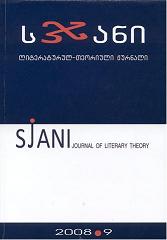ჭარბი რითმის გაგებისათვის
Towards Understanding Excessiveness of Rhyme
Author(s): Akaki KhintibidzeSubject(s): Literary Texts
Published by: ლიტერატურის ინსტიტუტის გამომცემლობა
Keywords: Excessive rhyme; Knight in the Panther's Skin; Georgian verses; Guramishvili; metric scheme; Galaktioni.
Summary/Abstract: The notion of excessive rhyme is not worked out yet. It is understood in its direct sense: There are two and three-syllable rhymes in “The Knight in the Panther’s Skin”s high and low verses, four-syllable rhymes are regarded as excessive. Such kind of interpretation is wrong. Four-syllable rhyme of “The Knight in the Panther’s Skin”: “naturqalsa-nasukalsa-nabuqalsa” (56), five-syllable rhyme: “moismenda-moitkenda-moilkhenda-tinatinebda” (52), like Galaktioni’s academy-nacadamy (“To Gothie”) – will not be considered as excessive. Some researchers cannot see longer than three-syllable rhymes (dactylic) and consider the above mentioned rhymes as “Super-dactylic”. Some of them think that there are not rhymes longer than five-syllable in Georgian. Georgian verses are inclined towards long rhymes. Guramishvili’s rhyme: shavberdebi-gavhmtverdebi-davmterdebi-davjerdebi - four syllable, Grishashvili’s: akikisebuls-akiskisebuls – five-syllable; Lado Asatiani’s: “gadabrialebit- shavbrialebit-shavnabdianebi – six-syllable, there are eight-syllable rhymes as well: gagvachorichorinebeno-dagvashorishorebeno (folklore). None of these rhymes are excessive. Metric scheme is defining feature for excessiveness of rhyme, correspondence with metric scheme, it does not correspond to the requirement of the scheme: is either shorter or longer it. Probably, the reader will argue with me: the word “excessive” has a negative connotation, but excessive rhyme does not provoke unpleasant feelings. It is true! Poets do not try to avoid excessive rhymes. They prefer its euphonic richness rather than its correspondence with metric scheme. In Galaktioni’s four-syllable rhymes there is more often three-syllable sound assent, in five-syllable rhymes – four-syllable. Excessive rhyme is actually beyond reader’s consciousness, as rhythm leads the poem; it does not exist without rhythm, but it is possible without rhyme. Rhyme, be it excessive or in correspondence with the metric scheme, cannot change the character of the verse. This it especially true for excessive rhyme, which is based only on phonics, as rhyme has some other parameters as well: rhythm and semantics, which are the primary defining features of its dignity, more than phonic. The semantics of rhyme means the collocation of whole words and not of parts of words, as in excessive rhyme. This misinterpretation comes from syllabic-tonic theory of Georgian rhyme, according to which, parts that come after stressed syllables in rhymed words are regarded as rhyme. Therefore, excessive rhyme does not have a negative impact on the verse, does not diminish its dignity that is why poets do not try to avoid using it (even Rustaveli and Galaktioni). Although, excessive rhymes are extremely rare in Lado Asatiani’s poems. Almost all of his rhymes correspond to the metric scheme. Almost all its rhymes correspond to metric sceme.
Journal: სჯანი
- Issue Year: 2008
- Issue No: 09
- Page Range: 105-108
- Page Count: 4
- Language: Georgian

